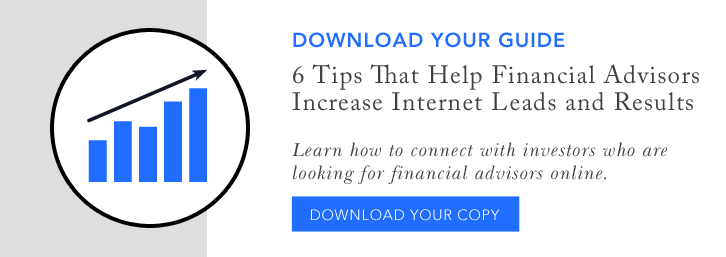4 Ways the Internet Can Generate Quality Leads for Financial Advisors
How to find clients as a financial advisor? Looking for the most efficient, economical way to generate leads for your financial advisory firm? We recommend using the four Internet-based strategies that are described in this article.
These strategies apply to any planning or investment firm that owns its brand and website.
It all starts with online visibility, a critical part of using the Internet to generate new qualified leads. Investors have to be able to find you so they can contact you.
Online visibility produces the traffic that your website needs to produce a steady flow of new leads. No traffic means no leads. Low traffic means a low volume of leads. Conversely, the more visible you are on the Internet the more leads your website will produce each month.
You don’t want any traffic. You want your ideal types of clients visiting your website. For example, if your ideal client is a Boomer then you want large numbers of Boomers visiting your website each month.
The Process Starts with a Great Online Presence
While it may seem obvious, publishing large amounts of content that no one reads is a waste of time and money. Google wants original content that is open and read by large numbers of investors. This is how you get page one visibility in Google.
Why page one? 91.5% of Google users do not scroll to page two.
If investors find your blog site or website and they find content that is relevant and useful, there is a much higher probability they will initiate contact with you.
You should be monitoring the content on your website and blog site to determine what is resonating with investors. If certain website pages have high bounce rates, be sure to update them with fresh content.
The same can be said about the content on our your blog site. If you have visitors, but no one is reading your articles or more importantly no one is contacting you then you need new sources that write, edit, and produce quality content for your blog site and website.
Start with the content on your website. Are visitors spending at least three minutes on the site? Do some of the pages have very high bounce rates?
Are visitors responding to free offers? Is all of the information current and accurate? Are they subscribing by filling out your landing pages so you can follow-up and contact them?
If you have a blog, are you publishing a consistent flow of new content? Is the content original and relevant? Did anyone read it? Google only gives SEO credit to original content. Downloading articles from libraries is a waste of time and money.
Next, you should audit all of your website’s pages. Is the content current? Has anything changed? Are you practicing transparency for the key information that investors are seeking when they visit financial advisor websites? Does your website have a lot of distractions?
Do you have any product or promotion-specific landing pages? Are they still current and accurate? If they are not, you should update the pages with more current information.
Next, make sure all of your CTAs (Calls to Action) are properly positioned and compelling. You want to make it easy for investors to contact you and their primary tool is your CTAs.
Viewers of your content should not be bombarded with CTAs, but they
should not have to look very hard to find ways to contact you. After all convincing visitors to contact you is the number one role of your website.
Social Media Marketing
Social media is a great resource for generating financial advisor leads online, if it is managed properly. Not managed properly, it is a tremendous waste of money - lots of money.
It helps if you think of your social media profiles as an extension of your website and the content on your blog site. Make sure your contact information is current and that you address any posts/comments or direct messages promptly. They may start out as a simple question but could turn into a valuable lead.
Also, some social platforms allow for a “contact us” form to be added to a business profile. Check all of your current pages to see if that’s an option for your business. If you don’t have any business social media pages, now is the time to create them. While there are many to choose from (and that number is growing daily) the most popular sites for financial advisors include Facebook, LinkedIn and Twitter.
These platforms allow you to measure your insights and analytics so you can see what types of content are performing the best and what characteristics describe your audience. You can use this information to target your ideal types of prospects if you choose to use paid social or display advertising.
Paid Advertising
While having a strong online presence is crucial for generating quality organic leads, paid advertising can also produce high quality leads. There are many types of paid advertising, including social media paid/sponsored posts, display advertising, paid search advertising and more.
Without getting too detailed, the general idea is that you can use paid advertising to reach a specific audience that aligns with your ideal type(s) of clients. For example, when running paid ads on social media, you can choose factors such as age, location, profession, estimated net worth, industry, retirement status, and more. These are just examples of some of the criteria and they can vary between different social media platforms.
The primary idea behind paid social media advertising, is that you are reaching people outside of your current followers, but have the characteristics of your follower base and could turn into future prospects. The key is to make sure your advertising content includes a lead generation tool, such as a contact form or email subscription form.
Display ads are similar in that they can be targeted to just about any set of characteristics to reach your target audience, however they don’t have to use a social media platform. Your ad could appear on any number of websites within the categories you choose that best match your audience’s demographics.
Gated Content is King
Gated content requires investors to submit their contact information in exchange for access to a free offer (eBook) that appears on your website. This content can be anything from a whitepaper, a newsletter, or access to a printable version of an infographic.
Gating content is a very common lead generation tool - the contact is free, but requires registration to access it. The key to this strategy is a “compelling” free offer that is strong enough that investors will register to obtain it.
You should be a little cautious in regard to the amount of information you ask during the registration process, in particular, required information. Less is better, and too much information may cause them to reject the offer and exit the website.
Consider making the landing page as short as possible and request the least amount of information you need to to send drip emails to the investors who want the information. If you want to gather more information, you should consider making some of the fields optional.
Once someone registers for your gated content, it’s crucial to make the first contact as soon as possible, perhaps an automated “welcome” email or even a personal email from you. Some advisors even call new registrants.
There are several ways the internet can be utilized to generate quality leads for your firm. Each process requires specialized expertise to be effective. If you don’t have the expertise in-house you should consider outsourcing the work to a digital marketing agency that specializes in providing these services to financial advisors: Paladin Digital Marketing. Paladin provides the expertise based on best practices and can do the work for you. Your job is to convert the leads into revenue-producing clients.


